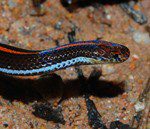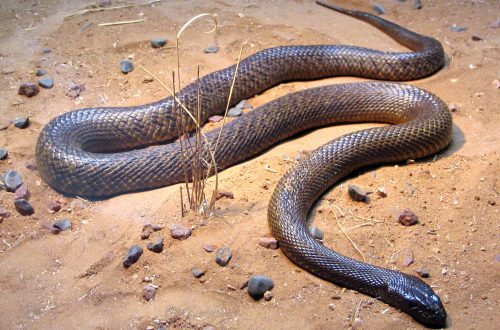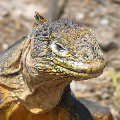
Galapagos terrestrial iguana
Conolof or the Galapagos land iguana is as rare a creature as the marine iguana. And although these animals are not close relatives, scientists happened to meet in the Galapagos Islands, where they live, presumably, interspecific hybrids. Surely such a crossing can lead to the appearance of a truly amazing creature, since both marine and terrestrial Galapagos iguanas are famous for their unique natural features. But so far, almost nothing is known about the individuals born from these unions. But there is enough information about their unusual parents, in particular, about the Galapagos land iguanas. They will be discussed in this article. The species Conolophus subcristatus is endemic to the Galapagos archipelago. These lizards look a bit like marine iguanas, maybe not so overweight, but they also resemble representatives of the prehistoric animal world. At one time, Charles Darwin, studying the fauna of the Galapagos, noted the abundance of terrestrial iguanas living there, but today they are almost exterminated, by the way, largely due to the fault of people. Of course, environmental organizations are trying to maintain and preserve the existing number of conolophos, but this has not yet led to a full-fledged revival of the species.
Contents
Classification
Kingdom: Animals
Type: Chord
Class: Reptiles
Order: Scaly
Suborder: Lizards
Family: Iguana
Genus: Conolophus, druzogolovy, or land iguanas, Conolophus
Species: Galapagos ground iguana, Conolophus subcristatus
Appearance
 The Galapagos terrestrial iguana is an unusually interesting reptile. It is quite large, however, not larger than the sea. It grows a little over a meter in length. The head of the conolophus is elongated, and the body is short and awkward with a rather thick at the base and tapering towards the end of the tail of a cylindrical shape, the length of which is almost half the length of the body. On the thick powerful neck of the lizard, the skin is collected in numerous transverse folds, on the nose, around the wide nostrils, there is a humpbacked nasal shield. On the back of the terrestrial Galapagos iguana there is a horny crest, but it is not as high as that of its aquatic relative. The highest part of the crest is on the back of the neck, on the back it is slightly lower, and on the tail it is barely noticeable. The keeled scales of the skin on the upper side of the body are arranged in regular transverse rows. In the mouth of the Galapagos reptile, an ovoid tongue with a slight indentation at the end. This is a very important organ involved in the unusual diet of lizards, which you can read about below. And of course, the Galapagos terrestrial iguana does not have swimming membranes – it simply does not need them. As for the limbs, the front paws of the lizard are longer, but thinner than the hind ones, and there are serious weapons on the fingers – sharp and powerful claws.
The Galapagos terrestrial iguana is an unusually interesting reptile. It is quite large, however, not larger than the sea. It grows a little over a meter in length. The head of the conolophus is elongated, and the body is short and awkward with a rather thick at the base and tapering towards the end of the tail of a cylindrical shape, the length of which is almost half the length of the body. On the thick powerful neck of the lizard, the skin is collected in numerous transverse folds, on the nose, around the wide nostrils, there is a humpbacked nasal shield. On the back of the terrestrial Galapagos iguana there is a horny crest, but it is not as high as that of its aquatic relative. The highest part of the crest is on the back of the neck, on the back it is slightly lower, and on the tail it is barely noticeable. The keeled scales of the skin on the upper side of the body are arranged in regular transverse rows. In the mouth of the Galapagos reptile, an ovoid tongue with a slight indentation at the end. This is a very important organ involved in the unusual diet of lizards, which you can read about below. And of course, the Galapagos terrestrial iguana does not have swimming membranes – it simply does not need them. As for the limbs, the front paws of the lizard are longer, but thinner than the hind ones, and there are serious weapons on the fingers – sharp and powerful claws.
Compared to the marine iguana, the land lizard looks much more impressive due to its bright body color. It combines yellow, red and brown tones. The bright head of a lemon shade turns into a darker neck, and then a brick-red color appears on the back, flowing from the sides into a restrained dark brown shade. And no olive and gray tones, familiar to other reptiles. But in general, the color of terrestrial Galapagos iguanas in different individuals may vary. For example, there are more reddish or more solid dark lizards. And, say, iguanas of pale tones are characteristic of Santa Fe Island, which they even tried to isolate as a separate species, but the assumption was not confirmed. It is this coloration and a number of other less noticeable, but obvious signs, that make it possible not to confuse terrestrial Galapagos iguanas with marine ones.
Distribution and habitation
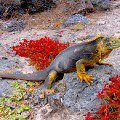 The Galapagos terrestrial iguana is a typical representative of the local fauna, but it is not found everywhere in the archipelago, but only on some islands – Santa Cruz, Isabel, Fernandina and Plaza. Previously, reptiles lived on the island of Santiago, but today the species is completely extinct in this area. Another island where you can find a lizard is New Seymour, but it was brought there.
The Galapagos terrestrial iguana is a typical representative of the local fauna, but it is not found everywhere in the archipelago, but only on some islands – Santa Cruz, Isabel, Fernandina and Plaza. Previously, reptiles lived on the island of Santiago, but today the species is completely extinct in this area. Another island where you can find a lizard is New Seymour, but it was brought there.
Like many other reptiles, Galapagos land iguanas are prone to digging holes in which they hide from the scorching sun. But in general, lizards are accustomed to the dry climate of the Galapagos and try to avoid coastal areas, living in the central area. A similar iguana lives in South America. The similarity of reptiles was once noticed by Darwin, who discovered conolophus. So, perhaps the South American lizard is the ancestor of the Galapagos. Of course, today the territories where the Galapagos terrestrial iguana lives are carefully protected from poachers, but it is not always possible to protect the laying of the lizard from rodents and wild cats. In addition, the vegetation necessary for the existence of the iguana is destroyed by goats common on the islands, so that the habitats of lizards suffer not only from the side of humans. Galapagos in general is an amazing world, home to many unique species of animals. And of course, humanity strives to preserve this natural corner. However, real actions and efforts are not always enough.
Behavior and lifestyle
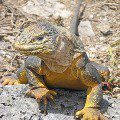 Various researchers of the Galapagos land iguanas sometimes give conflicting information about the biotopes preferred by lizards. Some write that reptiles settle only in the depths of the islands, away from the coast, others claim that they met conolophos both on wet hills and on coastal lowlands. Most likely, both assumptions are correct, but relative to the past, when the islands were truly teeming with Galapagos land iguanas. According to Darwin’s stories, his expedition to the Galapagos encountered difficulties in arranging an overnight stay on the islands, since the entire surrounding area was pitted with iguana burrows. The current situation, as already mentioned, is different. The number of terrestrial Galapagos lizards has decreased, despite all their caution. These reptiles never stray far from their burrows in search of food. But today, there is less available vegetation on the islands, so sometimes iguanas have to travel longer distances to find food. And since lizards are not very fast and clumsy, predators such as the Galapagos buzzard and, of course, poachers take advantage of this. Hearing the call of a buzzard and not being able to hide in a hole, the iguana freezes in place, hoping that the bird simply does not notice it. Sometimes, in order to catch the Galapagos iguana, this cry is imitated by people, and then they take the frozen lizard, which is called “bare hands”. This reptile cannot be called active, even during the day – during wakefulness – it moves slowly and lazily.
Various researchers of the Galapagos land iguanas sometimes give conflicting information about the biotopes preferred by lizards. Some write that reptiles settle only in the depths of the islands, away from the coast, others claim that they met conolophos both on wet hills and on coastal lowlands. Most likely, both assumptions are correct, but relative to the past, when the islands were truly teeming with Galapagos land iguanas. According to Darwin’s stories, his expedition to the Galapagos encountered difficulties in arranging an overnight stay on the islands, since the entire surrounding area was pitted with iguana burrows. The current situation, as already mentioned, is different. The number of terrestrial Galapagos lizards has decreased, despite all their caution. These reptiles never stray far from their burrows in search of food. But today, there is less available vegetation on the islands, so sometimes iguanas have to travel longer distances to find food. And since lizards are not very fast and clumsy, predators such as the Galapagos buzzard and, of course, poachers take advantage of this. Hearing the call of a buzzard and not being able to hide in a hole, the iguana freezes in place, hoping that the bird simply does not notice it. Sometimes, in order to catch the Galapagos iguana, this cry is imitated by people, and then they take the frozen lizard, which is called “bare hands”. This reptile cannot be called active, even during the day – during wakefulness – it moves slowly and lazily.
Food
The appearance of the Galapagos terrestrial iguana, as is already clear, is quite bizarre and even somewhat intimidating. And she has the same strange and unusual way of feeding for other reptiles, both the food itself and the mechanism of its absorption. This lizard feeds mainly on the fruits and leaves of the prickly pear cactus, and eats these parts of the plant right along with the thorns, so the thorns of these cacti have been repeatedly found in the iguana’s litter. This is how the Galapagos land iguana feeds: it patiently sits near a cactus, waiting for at least one fruit to fall from it. And if during the meal thorns dig into the lizard’s hind legs, then it will carefully pull them out with its front paws. The Galapagos iguana does not chew, but swallows the prickly pear fruit and small needles do not bother her at all. And if the thorn accidentally sticks into the tongue, then the lizard will pull it out with its paws or will make rotational movements with its tongue until the needle falls out by itself.
Occasionally, terrestrial Galapagos iguanas diversify their diet with fruits or flowers of other low-growing plants, as well as insects and found carrion. And young lizards at first prefer only insects. Prickly pear for these reptiles is a universal food that combines food and drink at the same time, since its fruits are juicy and fleshy. The needles pass through the digestive system of lizards without any difficulty, although if you look at the cactus from the side, then its thick spines, reminiscent of sewing needles, make a menacing impression. However, the mouth of the terrestrial Galapagos iguanas is designed so that these needles do not harm it, and the reptiles, apparently, do not feel pain from their injections.
Reproduction
The reproduction of Galapagos terrestrial iguanas is unique. In the male, this period is associated with every kind of demonstration of his advantageous sides in front of the female – a bright color, with special movements he attracts the chosen one. And if mating in a peaceful way fails, then the male uses force and simply catches the female. It is interesting to watch the “catch-ups” of these clumsy creatures.
Male Galapagos terrestrial iguanas are territorial and defend their habitats especially aggressively just in time for the mating season. At this time, the male and female can live in the same hole. But now the fertilization has taken place, and the female leaves the common dwelling in order to find a convenient place for laying. In search of such a lizard is able to walk as much as 15 km and stop, for example, near the crater of an extinct volcano, a pile of wet leaves, on loose sandy soil, or even tear open the masonry of another iguana to make her own in her place if she liked the surrounding conditions. At this time, the female Galapagos terrestrial iguanas are characterized by clashes, when the females, who have occupied the best sites, are forced to challenge their right to them with less fortunate neighbors. The reason for this is the lack of suitable territories for nests, despite the small number of the species. But when the place is finally found, the female Galapagos iguana digs a shallow burrow and lays up to 25 eggs in it, so that the female conolophas are quite prolific. The incubation period lasts 3-4 months, after which small lizards are born.
In fact, the breeding behavior associated with long migrations is surprising for terrestrial Galapagos iguanas. They are so slow that being at a not so great distance from their hole, a hundred meters, they can go back several days. But fertilized females travel extremely purposefully. Researchers have watched them slowly climb to the top of the volcano to lay their eggs in the still-warm soil of the crater. And the general inactivity of iguanas can be explained by their meager, monotonous and low fortified diet.
Male conolophos during the mating season can be so promiscuous that instead of an individual of their own species, they catch a female marine iguana. The reverse situation is also possible. Mating takes place, and the resulting offspring look like sea lizards, but live on land, like the Galapagos land iguanas.
Sources of
http://www.apus.ru
http://www.infox.ru/
http://www.floranimal.ru/
http://slovari.yandex.ru/
http://www.latindex.ru
http://www.vokrugsveta.ru/



